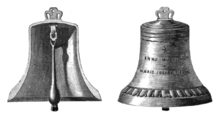Dove's Guide for Church Bell Ringers
Dove's Guide for Church Bell Ringers (known to ringers as "Dove's Guide" or simply "Dove") is the standard reference to the rings of bells hung for English-style full-circle bell ringing. The vast majority of these "towers" are in England and Wales but the guide includes towers from the rest of the British Isles as well as a few from around the world (including the United States, Australia, Canada, Africa and New Zealand). The latest edition is Dove’s Guide for Church Bell Ringers to the Rings of Bells of the World (11th Edition).
.jpg)
.jpg)
History
The guide was first published in 1950 by Ronald Hammerton Dove (Ron Dove, 1 June 1906 – 19 March 2001) under the title A Bellringer's Guide to the Church Bells of Britain and Ringing Peals of the World. Previously the location of rings of bells was a matter only of local knowledge and hearsay. Dove produced eight editions of his guide between 1950 and 1994, managing to visit and ring at nearly all the ringable towers himself (a never-ending task as rings are continually added, removed or upgraded and, at least in the Guide's early years, rediscovered).
After 1994, he handed over responsibility for the Guide to the Central Council of Church Bell Ringers. The 11th edition (December 2018) is the most recent published as a book (now under the title Dove's Guide) and is also made available as a database for free access via the Internet: the Central Council continues to maintain the guide online.
Contents
Entries in the Guide traditionally listed the town or village, the county (or country), the dedication (saint) of the church, the number of bells, the weight of the tenor (the largest bell) and its musical note, and the tower's usual practice night. It also noted whether the bells were in an unringable or unsafe condition. Appendices (not currently available online) also give information about rings of bells by number, weight, and county; a list of the heaviest bells in the British Isles; and details of changes since the previous edition. This information is helpful for those interested in trends over time. The online guide is, however, searchable by almost every criterion.
Although it was sometimes assumed to be exhaustive, Dove's Guide never pretended to be a complete catalogue. In fact, the Guide is under continual review and enhancement. Map grid references are now shown, and even details of towers as Points of Interest for users of satellite navigation systems: details of individual bells in each ring are being added gradually.
It is an invaluable aid for the holidaying bell ringer looking for a tower to visit, or for organising a tower grab (ringing outing). However, contact information for towers is still best obtained from individual websites and reports.[1]
Bibliography
Historic
- Dove, R. H. (1982) A Bellringer's Guide to the Church Bells of Britain and Ringing Peals of the World, 6th ed. Aldershot: Viggers
- Dove’s Guide for Church Bell Ringers to the Ringing Bells of Britain and of the World (2000)
Current edition
- Dove's Guide for Church Bell Ringers to the Rings of Bells of the World (11th Edition), John Baldwin, Tim Jackson & Ron Johnston (December 2018, Central Council), ISBN 978-1-911210-03-0, A5 format 330+pp
External links
References
- "Ringing Societies". The Central Council Of Church Bell Ringers. Retrieved 18 February 2016.
